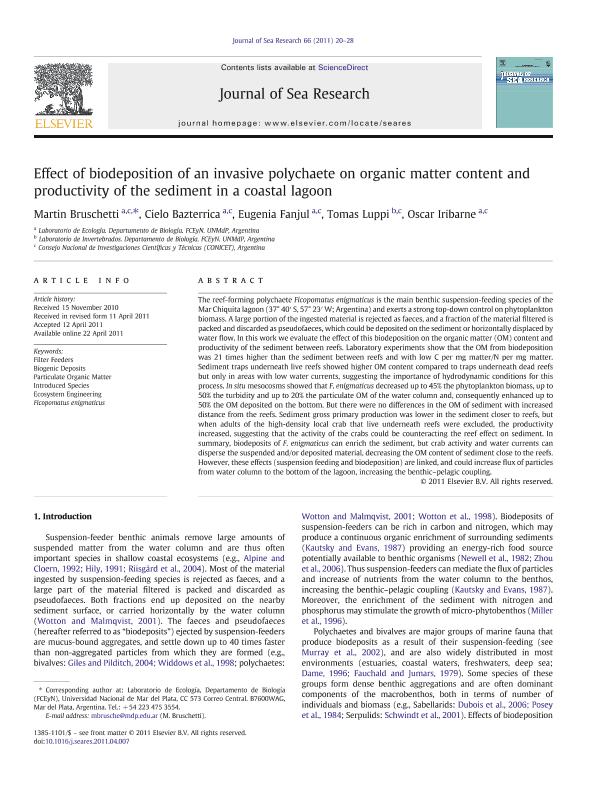Artículo
Effect of biodeposition of an invasive polychaete on organic matter content and productivity of the sediment in a coastal lagoon
Bruschetti, Carlos Martin ; Bazterrica, Maria Cielo
; Bazterrica, Maria Cielo ; Fanjul, Maria Eugenia
; Fanjul, Maria Eugenia ; Luppi, Tomas Atilio
; Luppi, Tomas Atilio ; Iribarne, Oscar Osvaldo
; Iribarne, Oscar Osvaldo
 ; Bazterrica, Maria Cielo
; Bazterrica, Maria Cielo ; Fanjul, Maria Eugenia
; Fanjul, Maria Eugenia ; Luppi, Tomas Atilio
; Luppi, Tomas Atilio ; Iribarne, Oscar Osvaldo
; Iribarne, Oscar Osvaldo
Fecha de publicación:
04/2011
Editorial:
Elsevier Science
Revista:
Journal of Sea Research
ISSN:
1385-1101
Idioma:
Inglés
Tipo de recurso:
Artículo publicado
Clasificación temática:
Resumen
The reef-forming polychaete Ficopomatus enigmaticus is the main benthic suspension-feeding species of the Mar Chiquita lagoon (37° 40′ S, 57° 23′ W; Argentina) and exerts a strong top-down control on phytoplankton biomass. A large portion of the ingested material is rejected as faeces, and a fraction of the material filtered is packed and discarded as pseudofaeces, which could be deposited on the sediment or horizontally displaced by water flow. In this work we evaluate the effect of this biodeposition on the organic matter (OM) content and productivity of the sediment between reefs. Laboratory experiments show that the OM from biodeposition was 21 times higher than the sediment between reefs and with low C per mg matter/N per mg matter. Sediment traps underneath live reefs showed higher OM content compared to traps underneath dead reefs but only in areas with low water currents, suggesting the importance of hydrodynamic conditions for this process. In situ mesocosms showed that F. enigmaticus decreased up to 45% the phytoplankton biomass, up to 50% the turbidity and up to 20% the particulate OM of the water column and, consequently enhanced up to 50% the OM deposited on the bottom. But there were no differences in the OM of sediment with increased distance from the reefs. Sediment gross primary production was lower in the sediment closer to reefs, but when adults of the high-density local crab that live underneath reefs were excluded, the productivity increased, suggesting that the activity of the crabs could be counteracting the reef effect on sediment. In summary, biodeposits of F. enigmaticus can enrich the sediment, but crab activity and water currents can disperse the suspended and/or deposited material, decreasing the OM content of sediment close to the reefs. However, these effects (suspension feeding and biodeposition) are linked, and could increase flux of particles from water column to the bottom of the lagoon, increasing the benthic–pelagic coupling.
Archivos asociados
Licencia
Identificadores
Colecciones
Articulos(IIMYC)
Articulos de INSTITUTO DE INVESTIGACIONES MARINAS Y COSTERAS
Articulos de INSTITUTO DE INVESTIGACIONES MARINAS Y COSTERAS
Citación
Bruschetti, Carlos Martin; Bazterrica, Maria Cielo; Fanjul, Maria Eugenia; Luppi, Tomas Atilio; Iribarne, Oscar Osvaldo; Effect of biodeposition of an invasive polychaete on organic matter content and productivity of the sediment in a coastal lagoon; Elsevier Science; Journal of Sea Research; 66; 4-2011; 20-28
Compartir
Altmétricas



